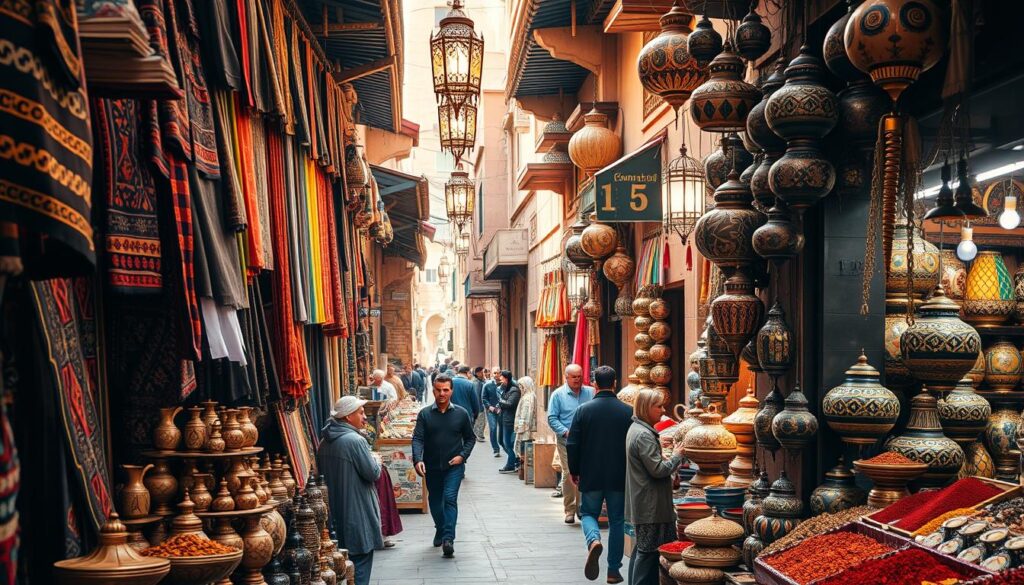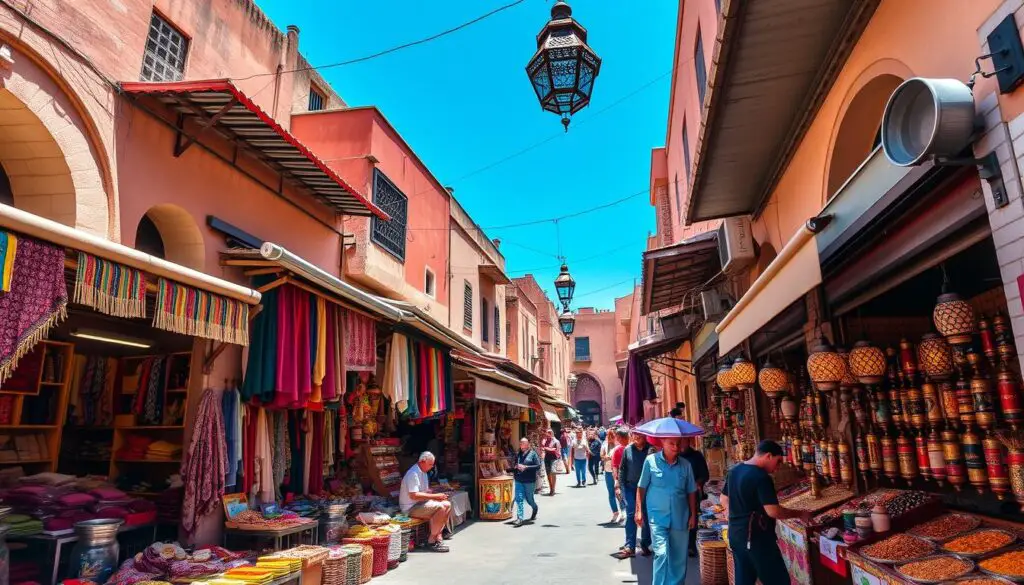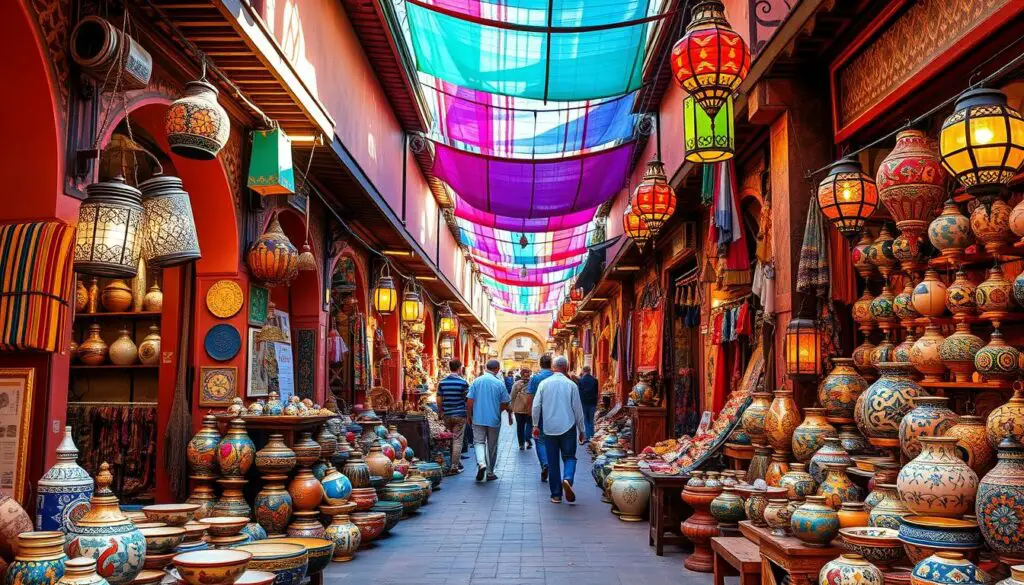As I stepped into Marrakech’s heart, the air was filled with exotic spices and merchants’ chatter. The sights, sounds, and smells of the souks amazed me. It was a true glimpse into Moroccan culture, rich with history and tradition.
Key Takeaways
- Marrakech’s souks are the largest markets in Africa, offering a sensory experience like no other.
- The souks are divided into sections based on the items sold, including carpets, slippers, spices, and leather goods.
- Guided tours provide a better understanding of the hidden gems and cultural traditions within the souks.
- Bargaining is an essential aspect of shopping in the souks, and understanding local customs can enhance the experience.
- The souks are not just a shopping destination but also a window into Moroccan history and heritage.
Understanding the Heart of Marrakech’s Medina
The Medina in Marrakech is a treasure trove of history and culture. It’s a UNESCO World Heritage site filled with rich traditions. The streets and markets, known as souks, show the heart of Moroccan culture.
Historical Significance of the Medina
The Medina of Marrakech has a long history, starting in the 11th century. It was founded by the Almoravid dynasty. Over time, dynasties like the Almohads, Merinids, and Saadians shaped its architecture and culture.
Layout and Architecture
The Medina’s streets are designed to be narrow and shaded. This layout provides privacy and comfort in the bustling market. The architecture combines African, Arab, and Berber styles, creating a unique look.
Cultural Heritage Status
The Medina of Marrakech is a UNESCO World Heritage site. This honor highlights its cultural importance. It shows the Medina’s role in keeping Moroccan traditions alive.
Visiting the Medina’s souks is essential. It lets you see the essence of Moroccan culture and the traditional markets that have existed for centuries.
A Sensory Journey Through Traditional Moroccan Markets
Exploring Marrakech’s Moroccan markets, or souks, is a feast for the senses. You’ll see a world of colors as you walk through narrow streets. Textiles and spices add to the vibrant atmosphere.
The air is filled with the smells of Moroccan spices. You’ll catch scents of cumin, coriander, saffron, and cinnamon. These smells tell a story of Moroccan cooking traditions.
The sounds of the souk atmosphere are just as engaging. You’ll hear vendors calling out and traditional music playing. The mix of sounds and sights is truly unique.
For those who love to touch and feel, the Moroccan markets are a dream. You can meet artisans and see how they make exotic Moroccan products. It’s a chance to learn about their skills and traditions.
Here, you can feel the softness of rugs, the metalwork of lanterns, and the leather of goods. The souks let you connect with Moroccan culture in a special way.
“Exploring Marrakech’s souks is a transformational experience, engaging all five senses and immersing visitors in the vibrant heart of Moroccan tradition.”
A trip through Marrakech’s markets is unforgettable. It’s a journey of sights, sounds, and smells that leaves a lasting impression.
Essential Guide to Marrakech’s Major Souks
In the heart of Marrakech’s medina, a maze of Marrakech souks awaits. Each souk offers a unique taste of traditional Moroccan shopping. These markets are the largest and most vibrant in Morocco, inviting visitors to dive into a world of sights, sounds, and smells.
Souk Semmarine: The Main Artery
Souk Semmarine is Marrakech’s market heart. It’s filled with textiles, jewelry, pottery, and spices. Explore its winding paths and find pottery stalls where artisans display their beautiful work.
Souk el Kebir: Leather Paradise
Enter Souk el Kebir, the leather district, for a journey into Moroccan craftsmanship. Here, artisans make babouches, traditional Moroccan slippers, and a wide range of leather items.
Souk des Teinturiers: The Dyers’ Quarter
Discover Souk des Teinturiers, the Dyers’ Quarter, for a splash of color and tradition. Watch artisans dye fabrics using ancient methods, creating stunning colors that amaze.
Marrakech’s souks offer something for everyone. Whether you’re looking for traditional goods, unique handicrafts, or a peek into the city’s culture, these markets will impress you.
“Exploring the souks of Marrakech is like stepping into a living, breathing kaleidoscope of culture and tradition.”
Moroccan Magic: Discovering Marrakech’s Vibrant Souks
The souks of Marrakech take you to another world. They show off the city’s rich culture through their architecture and trading traditions. Every corner is a new discovery, blending old traditions with modern commerce.
Marrakech has the biggest market in Africa, with souks for carpets, slippers, spices, and leather. A private guided tour is the best way to explore these markets. It offers insights into their history and cultural importance.
But, remember to respect the souks’ rules. Shopkeepers might get upset if you take photos without asking. Always ask for permission before taking pictures.
| Souk Exploration Highlights | Duration | Popularity |
|---|---|---|
| Spice Souk | 3-4 hours | Highly Recommended |
| Textile Souk | 2-3 hours | Highly Recommended |
| Leather Souk | 2-3 hours | Highly Recommended |
The Moroccan souks are a mix of history, culture, and commerce. They are a must-see in Marrakech. From the lively spice markets to the detailed leather workshops, each souk has its own story. They invite you to dive into the Moroccan Magic that fills these iconic places.
Artisanal Treasures and Traditional Craftsmanship
Marrakech’s souks are filled with amazing Moroccan crafts. They show the area’s rich culture and skilled art. Visitors can dive into the world of traditional goods, like carpet weaving, metalwork, and lantern making.
Carpet Weaving Techniques
Carpet weaving is a long tradition in Marrakech. Artisans spend 3-4 months on each rug. Visitors can see the weavers at work, amazed by the detailed patterns and colors.
These Moroccan crafts are beautiful and show the artisans’ hard work and skill.
Metalwork and Lantern Making
Metalwork and lantern making are also important in Marrakech’s souks. Artisans create stunning brass and copper pieces. Visitors can watch them work and learn about their traditional techniques.
Leather Goods Production
In Souk el Kebir, you can see how leather goods are made. From bags to belts, these traditional Moroccan goods are made with care. Visitors can talk to the artisans and even make their own purchases.
“Marrakech’s souks are a sensory delight, where the sights, sounds, and scents of traditional Moroccan craftsmanship come alive.”
Exploring Marrakech’s souks is a unique experience. It lets visitors see the artisanal treasures and understand the city’s rich culture and artistry.
The Art of Spice Trading in Marrakech
Marrakech’s souks are filled with Moroccan spices, taking you on a journey through the region’s rich food history. The Rahba Kedima Square is at the center, known for its wide variety of aromatic Moroccan products.
Walking through the alleys, you’ll smell saffron, cumin, and Ras El Hanout. This special spice mix has up to 30 spices. The colors and sounds of vendors invite you to check out the Moroccan spice markets. Each stall shows the country’s long-standing food traditions.
The souks also showcase Moroccan craftsmanship. You’ll see hand-woven carpets and carved lanterns. The souk atmosphere celebrates Moroccan culture and the artisans’ skills.
“The souks of Marrakech are a feast for the senses, where the scent of spices and the hum of activity transport you to a world of ancient traditions and modern innovation.”
Exploring the Moroccan spice markets in Marrakech is a must for anyone. Dive into the lively souk atmosphere and learn about Moroccan cuisine and culture.
Navigating and Bargaining Like a Local
Exploring Marrakech’s souks is a deep dive into culture. It’s not just about haggling over prices. It’s about building rapport with vendors and knowing the local ways. Those who get good at souk bargaining find authentic Moroccan shopping and unique treasures.
Essential Haggling Techniques
Haggling is a big part of souk shopping. Start by saying “Salaam Alaikum” and praising the vendor’s goods. Begin with an offer that’s 30-50% of the asking price. Then, negotiate politely, increasing your offer.
If the vendor won’t meet your price, be ready to leave. This can often lead to a better deal.
Cultural Etiquette Tips
- Dress modestly and respectfully to show deference to Moroccan culture.
- Avoid aggressive or confrontational bargaining tactics, which can be seen as rude.
- Engage vendors with a warm smile and make eye contact to build rapport.
- Refrain from handling merchandise unless you intend to purchase it.
Common Scams to Avoid
While most vendors in Marrakech are honest, tourists should watch out for scams. These include being overcharged, pressured to buy unwanted items, or being led to overpriced workshops. Stay alert, trust your instincts, and walk away if a deal seems too good.
By learning the local customs and souk bargaining techniques, visitors can confidently shop in Marrakech. They’ll find unique souvenirs that truly capture Moroccan culture.
Hidden Gems and Secret Corners
Beyond the busy streets, Marrakech’s Moroccan souks hold many hidden treasures. Explore secluded workshops, peaceful courtyards, and shops with exotic Moroccan products.
Le Jardin Secret is a 19th-century Islamic garden in the Medina. It’s a calm spot away from the bustling markets. Here, you can see the city’s rich history and culture.
In the Medina, find Maison de la Photographie. It’s a museum with old photographs from the late 19th century. It gives a unique look at Marrakech’s past and its photography history.
Join a guided tour like the Private Marrakech Souks Tour. Local guides like Kamal will show you the souks’ hidden spots. You’ll see traditional crafts and learn about the city’s culture.
These hidden spots offer a peaceful escape or a deep dive into Marrakech’s culture. So, explore the Marrakech markets and discover something new.
Authentic Moroccan Shopping Experience
Dive into the lively Moroccan shopping world by checking out Marrakech’s bustling souks. These markets are filled with traditional Moroccan goods. You’ll find everything from beautiful hand-woven carpets to colorful ceramics and fragrant spices.
Best Times to Visit
The souks open from 9 a.m. to 9 p.m. every day. But, the best time to go is early morning. The morning is quieter, making it easier to souk bargain without the crowds. Plus, vendors have their freshest goods ready in the morning.
Must-Buy Items
- Spices: Check out the wide range of aromatic spices like saffron, cumin, and ras el hanout.
- Leather Goods: Find amazing leather items, such as bags, wallets, and belts, made by skilled artisans.
- Rugs: Discover the beauty of Moroccan rug weaving with its intricate designs and vibrant colors.
- Ceramics: Take home beautifully made pottery, from detailed tagines to colorful tiles and vases.
- Traditional Clothing: Look for traditional Moroccan djellabas, caftans, and textiles.
Price Guidelines
Prices in the souks can change a lot. It’s smart to compare prices and bargain with vendors. Carry cash in Moroccan dirhams for easier transactions. Remember, souk bargaining is a big part of the Moroccan shopping culture.
| Item | Approximate Price Range (Moroccan Dirhams) |
|---|---|
| Spices (per 100g) | 10-50 MAD |
| Leather Goods | 100-500 MAD |
| Rugs (small size) | 500-2,000 MAD |
| Ceramics | 50-300 MAD |
| Traditional Clothing | 200-1,000 MAD |
“Bargaining in the Marrakech souks is an art form. It’s all about finding the right balance of persistence, patience, and respect.”
Conclusion
Exploring the vibrant souks of Marrakech is a journey into Moroccan culture. The Moroccan Magic in these markets is a mix of sights, sounds, and smells. Each visit to the Marrakech markets brings new discoveries and memories.
The souks of Marrakech are special because they let you get lost in Moroccan life. You can enjoy the sights, sounds, and smells from the stalls. Here, artisans show off their skills in carpet weaving, metalwork, and leather goods.
The markets are full of life and color. They invite you to try local food, learn about the culture, and find unique treasures. Exploring Marrakech’s souks is a must for anyone wanting to dive into the city’s rich culture.







